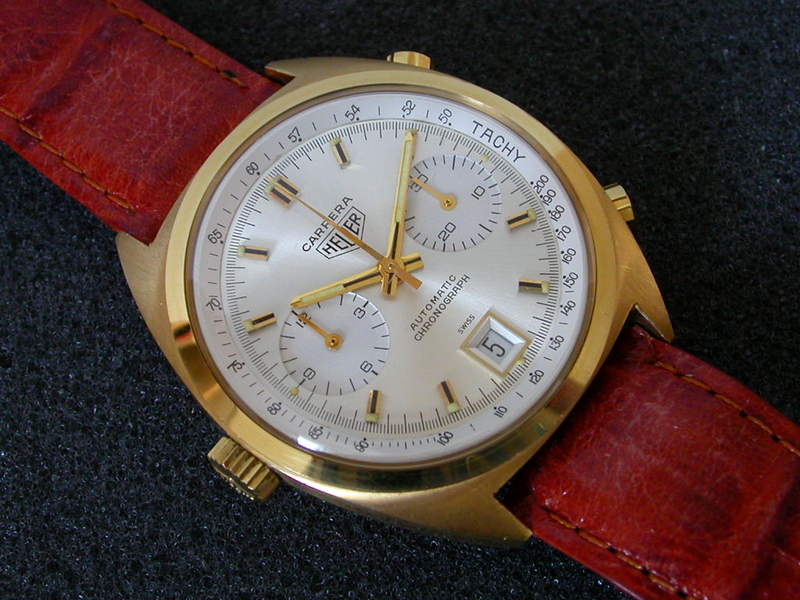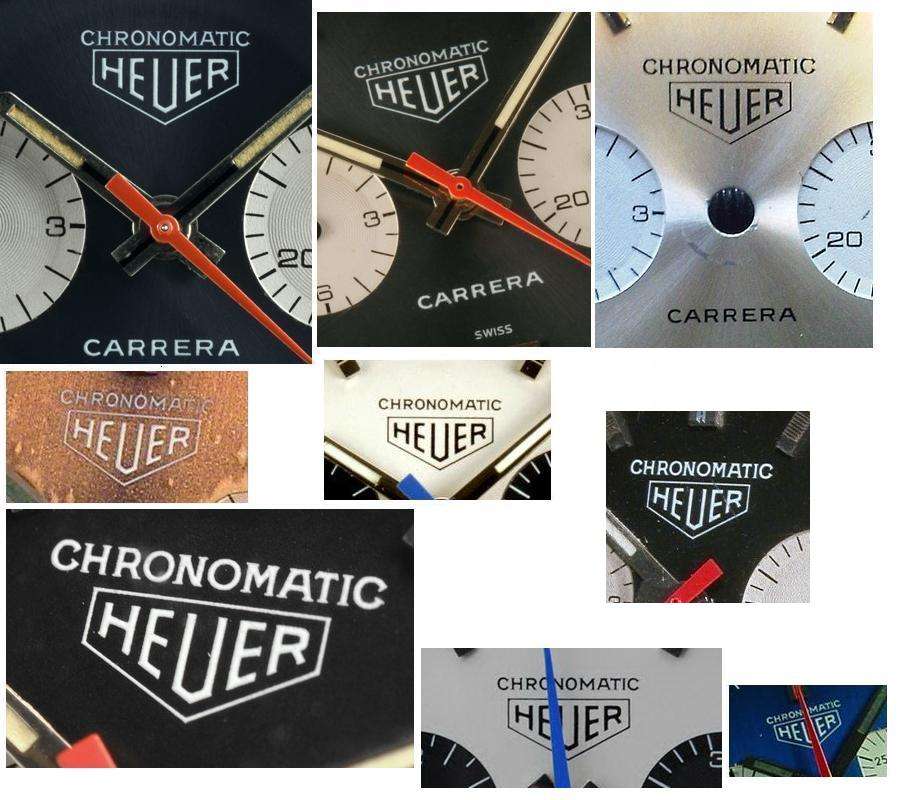| Informational Websites | ChronoMaddox -- the legacy of Chuck Maddox | OnTheDash -- vintage Heuer website | Zowie -- Omega information |
| Discussion Forums | ChronoMaddox Forum | Heuer Forum | Omega Forum |
| Counterfeit Watchers | ChronoTools Forum | ChronoTrader Forum |
|
|
The largest independent, non-commercial, consumer-oriented resource on the Internet for owners, collectors and enthusiasts of fine wristwatches. Online since 1998. | |||||||
|
||||||||
|
||||||||
 |
Vintage Heuer Discussion Forum
The place for discussing 1930-1985 Heuer wristwatches, chronographs and dash-mounted timepieces. Online since May 2003. | ||||||
| |||||||
| |||||||
As always Mark a very good and well structured read, you really could do a Carrera book, I would support you with materials and watches if you wish, so first upfront also my sincere compliments for your posts and work here onthedash.
The world of vintage Heuers has changed a lot of the past three years, today we see only parts for sale and few original watches, recently on ebay you could buy Monaco cases, Carrera dials, boxes, tons of straps, hands, pushers for 180 e......, we did not have this few years ago....however that is a different discussion.
Back to the advertised and discussed Carrera dial, just a few qusetions I would have and I wonder if you or other readers could answer:
Screenprinting techiques of the 70is: different logo and productname position on different dials, reason ?
Different typos across A, C, M ?
Explain Heuer thin frame and R typo, thin print vs thicker print past and today ? Is Carrera parallel to Chronomatic ?
Singer was on every Carrera dial or just on Chronomatics ?
Who printed low volumes dials Singer or Heuer, who printed Logos and product names ?
Where the dials foiled on top of the starburst ? Was there a lauqered finish put in top ?
Was a gold date frame used with gold inserts or were these mixed ?
Are marks on a dial a prove that a dial was mounted in a watch ?
How many Carrera Chronomatics do you know and in what case number frames are those ?
Any S dials you know of ?
....
Would be interesting to get more infos on Carrera Chronomatics...
Cheers
Arno
: I took a while to look at this one, digest some of the valid points
: that people have come up with and see what I really thought of
: it.
: Jeff is already familiar with my concept of the "known
: unknowns", a (mental) list of watches I keep that I have
: never seen in the metal, in a photo, or in documentation, but I
: have reason to believe may exist. As opposed to an "unknown
: unknown", which would be a complete surprise of a watch.
: Some of the known unknowns have since appeared - the 2447 NT
: first execution and 1153 S 'Yachting' spring to mind.
: One of the watches on there is an 1153 Chronomatic in silver. I
: have seen sales documentation stating the Carrera Chronomatic
: was available in charcoal and silver, but it was from a
: third-party rather than Heuer themselves. Nonetheless, I
: believed (and continue to believe) that there is a good
: possibility that the Carrera with Chronomatic marked dial was
: available in both N and S versions. Not to do so would have
: broken with a long standing Carrera tradition and run contrary
: to the Autavia, which had less history of silver/white dials
: before the Siffert. I also entertained the possibility of an
: 1158 with Chronomatic dial, but that felt a bit less likely. On
: the basis of the earliest watches and catalogues, I suspected
: that if an 1158 Chronomatic did exist, it would most likely have
: the silver dial.
: And now we have a silver dial before us, with non-contrasting
: registers (well, not quite but I'll come to that), which would
: suggest that it was intended for an 1158 rather than the 1153.
: The 1153 S Chronomatic, if it exists, I feel would have the same
: black registers as the later series production model. That this
: dial also has gold markers is a clincher - there's no reason for
: an 1153 to have anything other than steel markers. And as Paolo
: pointed out, it is correctly missing the onyx 12 o'clock marker
: from later watches, just like this early watch does:
:
: 
: Plus the Singer marking is correct, as Paolo also notes.
: The script gave me some pause for thought. So I put a little
: Chronomatic collage together:
:
: 
: Some people have noted that it's not a good fit for the Chronomatic
: 1153 Ns we know of. I would agree, there are a number of
: differences against those dials. Not a good match against the
: Monacos or the Autavia 1163 T either, look where the
: "Chronomatic" text on those lines up against the Heuer
: shield.
: And then.... and then we come up against the Autavia 1163 MH. Very
: different script on those compared to the 1163 T. The text is
: wider, with the C, h, i and c all being more or less outside the
: width of the Heuer shield. The Cs are nearly closed, with
: elaborate serifs. The first O is slightly oval, the second more
: round, unlike the other Chronomatics where both Os are more
: distinctly oval. And we see all the same things on this
: "new" Carrera dial. Which bodes well for originality -
: we have no other 1158 Chronomatics to compare it against, but we
: can see echoes in a sister model.
: I'm not sure why there are comments about it not being mounted on a
: watch. It clearly has been. There are marks where the hands have
: been removed, wear from the tachy bezel and marks on the reverse
: where it has been mated to a movement. Whether this was in 1969
: or subsequently is impossible to tell, but I would say if has
: definitely been part of a watch at some point. None of those
: scream to me prototype dial, not intended for sale.
: What might suggest that, though, are the registers. They are
: white rather than the clear silver of what we usually consider
: the finished article. Let's use Paolo's to demonstrate:
:
: 
: Clearly the registers are finished in the same silver as the rest
: of the dial. The other Chronomatic dials didn't have a metallic
: finish on the registers but that shouldn't have been a problem
: for Singer - they had supplied silver starburst dials with
: silver registers for the launch of the Carrera in 1964 after
: all. But these white ones don't look to have been ground down
: and refinished - the ridges are still clearly visible. Let's
: remember how these chronograph dials are typically constructed
: though. They are a series of plates pressed together in a
: sandwich, allowing for the registers to have this recessed look
: and easily to be in a different colour from the dial itself.
: And hang on a bit more. From the photo of:
:
: 
: can we be entirely sure that one doesn't have white registers too?
: Hard to be sure from the photo, but I wouldn't rule it out
: entirely. You'll note that both early dials have a radial
: starburst finish rather than the vertical brushing of later
: watches too. Paolo, as you have tracked down the owner, do you
: think he could confirm for us whether that example has white or
: silver registers? And Rich, can you confirm the colour of the
: date window surround?
: All considered, I'm definitely leaning towards genuine. Will be
: interesting to see the replies to my two queries above.
| Chronocentric and zOwie site design and contents (c) Copyright 1998-2005, Derek Ziglar; Copyright 2005-2008, Jeffrey M. Stein. All rights reserved. Use of this web site constitutes acceptance of the terms of use. | CONTACT | TERMS OF USE | TRANSLATE |